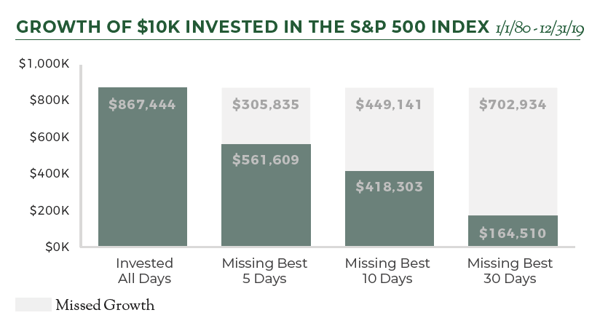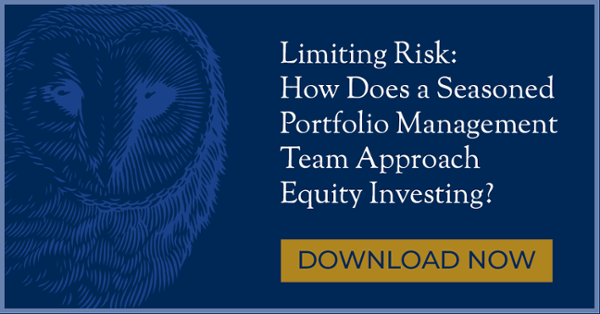Five Stats to Keep Clients Invested Through a Volatile Market
It’s a natural reaction to every bear market. As stocks plummet, clients start wondering whether they should pull money out of equities and wait on the sidelines until conditions improve. If you’re an advisor, you may have had several conversations along these lines recently. We salute your efforts to help clients stay the course.
At Dana, we realize the importance of staying fully invested and reflect it in our investment process, which dictates that funds hold minimal cash. Our view is that it is always better to stay fully invested because not even experts can perfectly time a rebound.
However, we know it can be challenging for advisors to keep their clients invested through a downturn. In the spirit of helping, below are five quick-reference stats and charts we’ve collected that paint a picture of why we believe it’s important to stay in equities through the entire market cycle:
- Even a Few Missed Days Can Have a Long-Term Effect. The first chart is one of our own. It demonstrates how missing just a few of the market’s best days can set an investor back over the long term. The green bar to the far left shows the growth of a $10,000 investment since 1980. The gray shading in the subsequent bars demonstrates what an investor would miss if they were on the sidelines for the market’s best five, 10 or 30 days.
For illustrative purposes only. Investors cannot invest directly in an index.
- In the current market environment, big days are easy to miss. The chart above shows the impact of missing a few days. It’s also important to note that some of those best days can follow the worst, which is why one should not move to cash in the current market environment. The last two weeks serve as a prime example: On three different days since March 24, the S&P 500 has posted returns of 9.4%, 6.2% and 7%, respectively.¹
- Bear markets don’t typically last long. This is another point to remind clients. Historically, investors haven’t needed to wait long before the market improves. According to Dow Jones Market Data, reported by Marketwatch, the average bear market for the S&P 500 index is 146 days, or roughly five months. And on average, it takes stocks 83 days from the time the index enters a bear market to when it reaches its trough.
- The best returns often come at the beginning of that bull market. As this Wall Street Journal article points out, a person who invested $100,000 in the S&P 500 at the beginning of the last bull market would have made, $630,000. Had they sat out the just first three months, they would have made only $450,000. The point: If a client is on the sidelines when things are uncertain, they will miss a substantial portion of the market’s returns.
- Returns are more consistent with a long-term view. A recent Morningstar article did a good job of putting patience in perspective. If clients can ride out the volatility and keep a long-term view, stock market returns appear more consistent. Per the article:
- Of the 94 one-year periods since 1926, 25 have resulted in a loss.
- Of the 90 overlapping five-year periods since 1926, only 12 have resulted in a loss.
- Of the 80 overlapping 15-year periods since 1926, none have resulted in a loss.
As these data points suggest, history shows investors can benefit when they ignore the volatility, take a long-term view and stay fully invested. We practice the same philosophy with our own mutual funds, and hope the stats above will help advisors keep their clients on track.
Past performance is not a guarantee of future results. The funds may lose money due to fluctuations within the stock market which may be unrelated to individual issuers and could not have been predicted. The price of the securities which the funds hold may change unpredictably due to local, regional, international, or global events. In the case of a general market downturn, multiple asset classes, or the entire market, may be negatively affected for an extended and unknown amount of time.
The Dana Funds are distributed by Ultimus Fund Distributors, LLC. There is no affiliation between Ultimus Fund Distributors, LLC. and the firms referenced in this blog post.
By clicking on the links above, you will be redirected to websites maintained by third parties.
Dana Large Cap Equity Fund top-ten holdings as of March 31, 2020: Microsoft Corp (2.70%), Apple, Inc. (2.66%), Intel Corp (2.43%), Amazon.com, Inc. (2.34%), Alphabet Inc. Class A (2.32%), LAM Research Corp. (2.28%), Walmart, Inc. (2.27%), Merck & Co, Inc. (2.20%), T-Mobile, Inc. (2.15%), Visa, Inc. (2.15%)
Dana Small Cap Equity Fund top-ten holdings as of March 31, 2020: Five9, Inc. (2.52%), Southwest Gas Corp (2.43%), Horizon Therapeutics (2.25%), Emergent BioSolutions, Inc. (2.24%), Qualys, Inc. (2.22%), Coherus BioSciences, Inc. (2.19%), Rapid7, Inc. (2.17%), BioTelemetry, Inc. (2.13%), Repligen Corp (2.12%), Chesapeake Utilities Corp (2.10%)
Dana Epiphany ESG Equity Fund top-ten holdings as of March 31 2020: Microsoft Corp (2.72%), Apple, Inc. (2.68%), Alphabet, Inc. Class C (2.67%), Amazon.Com, Inc. (2.43%), Intel Corp (2.23%), General Mills, Inc (2.22%) LAM Research Corp (2.16%), Hill-Rom Holdings, Inc. (2.12), Fidelity National Information Services, Inc. (2.10%), Pepsico, Inc. (2.07%)




